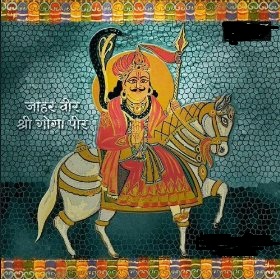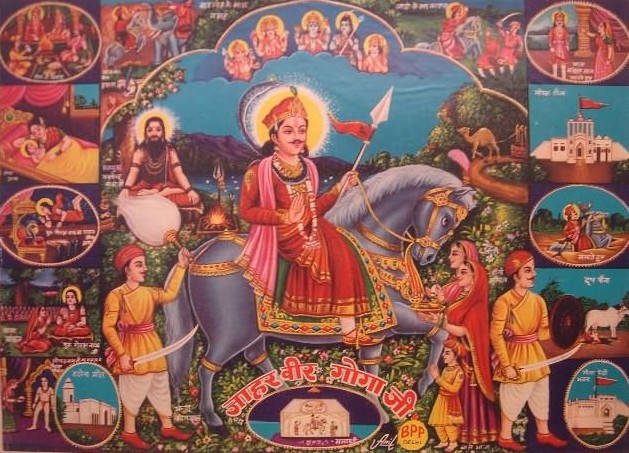Chhapar Mela on:
[Wikipedia]
[Google]
[Amazon]

 Chhapar Mela is celebrated in the village of Chhapar in the district of
Chhapar Mela is celebrated in the village of Chhapar in the district of

 Chhapar Mela is celebrated in the village of Chhapar in the district of
Chhapar Mela is celebrated in the village of Chhapar in the district of Ludhiana
Ludhiana () is the most populous Cities in India, city in the Indian state of Punjab, India, Punjab.164.100.161.224
http://164.100.161.224 › filesPDF
Ludhiana State: Punjab Business & Industrial Centre, Tier 2 1 ... The city has an estima ...
, Punjab
Punjab (; ; also romanised as Panjāb or Panj-Āb) is a geopolitical, cultural, and historical region in South Asia. It is located in the northwestern part of the Indian subcontinent, comprising areas of modern-day eastern Pakistan and no ...
, India every year in September. This mela (fair), held in memory of Gugga
Gogaji Chauhan, also known as Jahirpeer or Jaharveer Chauhan, is a folk Hindu deity in the northern India. He is worshipped in the northern states of India especially in Rajasthan, Himachal Pradesh, Haryana, Uttarakhand, Punjab region, Uttar P ...
is one of the most popular and spectacular festivals of the Malwa belt of Punjab.
This three-day fair commemorates the descent of the Gugga Veer, a Chauhan Rajput
Rājpūt (, from Sanskrit ''rājaputra'' meaning "son of a king"), also called Thākur (), is a large multi-component cluster of castes, kin bodies, and local groups, sharing social status and ideology of genealogical descent originating fro ...
, into the bosom of Mother Earth along with his steed.
According to the legend, he obsessed extraordinary powers over all kinds of snakes. The fair is celebrated at Gugge di Marhi, a big holy place built in his memory that has a reputation for curing people of snake bites. Earth is scooped up seven times to appeal to Gugga Veer for safety against snakes.
People sing folk songs and present folk dances. The fair is held on the Anant Chaturdashi
Ananta Chaturdashi () is a festival dedicated to Vishnu, observed and celebrated by Hindus. It is marked on the fourteenth day of the moon's waxing phase during the Hindu month of Bhadrapada. According to the ''Agni Purana'', the Ananta (Shesha ...
on the 14th day of the bright half of the Bhadon
Bhādõ (Shahmukhi: ; Gurmukhi: , ) is the sixth month of the Nanakshahi calendar and Punjabi calendar.
This month coincides with Bhadra in the Hindu calendar and the Indian national calendar, and August and September in the Gregorian and ...
(mid-August through mid-September as per the Hindu calendar
The Hindu calendar, also called Panchangam, Panchanga (), is one of various lunisolar calendars that are traditionally used in the Indian subcontinent and Southeast Asia, with further regional variations for social and Hindu religious purposes ...
).
People mainly worship the snake embodiment of Gugga
Gogaji Chauhan, also known as Jahirpeer or Jaharveer Chauhan, is a folk Hindu deity in the northern India. He is worshipped in the northern states of India especially in Rajasthan, Himachal Pradesh, Haryana, Uttarakhand, Punjab region, Uttar P ...
at this fair. The fair falls on the fourteenth day of Shukla Paksha
Paksha () refers to a fortnight or a lunar phase in a month of the Hindu lunar calendar.
Literally meaning "side", a paksha is the period either side of the '' purnima'' ( full moon day). A lunar month in the Hindu calendar has two fortnights, ...
of the month of Bhadrapad
Bhadra or Bhadrapada or Bhādo or Bhadraba
(Bengali: ভাদ্র ''bhādro''; Hindi: भादों ''bhādo''; Sanskrit: भाद्रपद ''bhādrapada''; ''Bhādra''; ''Bhādravo''; ''Bhadraba''; ''Bhadô'') is the sixth month ...
every year. It is believed that the Chhapar Fair was started around 150 years ago by a small congregation of devotees. In recent years the number of people attending the fair has risen to millions.
The Minor Chhapar Mela is also held at the same place. The special trend of scooping the land (seven times) is also practised at this fair. People consider digging of land will bring Gugga
Gogaji Chauhan, also known as Jahirpeer or Jaharveer Chauhan, is a folk Hindu deity in the northern India. He is worshipped in the northern states of India especially in Rajasthan, Himachal Pradesh, Haryana, Uttarakhand, Punjab region, Uttar P ...
Veer to protect them against snakes. The fair has much music, fun and dance. The fair has emerged as a grand festival in the past few decades.
The legend narrates the story of a boy and a snake born together in an agricultural family in Chhapar village. The serpent and the boy were so intimate that if one suffered a pain the other used to cry. One day the mother of the child went to the fields after laying him on a cot. To save him from the scorching sun, the snake stretched its hood over him. Thinking that the snake was going to bite the child, a passerby killed it with a stick. The child died immediately after the death of the snake and the family was left in sorrow. The family was advised by the elders to perform religious ceremonies to worship Gugga
Gogaji Chauhan, also known as Jahirpeer or Jaharveer Chauhan, is a folk Hindu deity in the northern India. He is worshipped in the northern states of India especially in Rajasthan, Himachal Pradesh, Haryana, Uttarakhand, Punjab region, Uttar P ...
and Siddha
''Siddha'' (Sanskrit: '; "perfected one") is a term that is used widely in Indian religions and culture. It means "one who is accomplished." It refers to perfected masters who have achieved a high degree of perfection of the intellect as we ...
and a he-goat
The goat or domestic goat (''Capra hircus'') is a species of goat-antelope that is mostly kept as livestock. It was domesticated from the wild goat (''C. aegagrus'') of Southwest Asia and Eastern Europe. The goat is a member of the family Bo ...
was left free to mark the place of worship by striking at a particular place. The place was recognised as Mari Gugga
Gogaji Chauhan, also known as Jahirpeer or Jaharveer Chauhan, is a folk Hindu deity in the northern India. He is worshipped in the northern states of India especially in Rajasthan, Himachal Pradesh, Haryana, Uttarakhand, Punjab region, Uttar P ...
where people from all walks of life have been worshipping Gugga on the fourteenth day of the bright half of the month of Bhadon every year. The farmers of the Malwa
Malwa () is a historical region, historical list of regions in India, region of west-central India occupying a plateau of volcanic origin. Geologically, the Malwa Plateau generally refers to the volcanic plateau, volcanic upland north of the ...
belt recognise the fair to the extent that they change the agricultural chores according to the dates of the mela.
People also narrate another story regarding the second fair known as Minor Chhapar Mela. At the beginning of the 20th century, the Maharaja
Maharaja (also spelled Maharajah or Maharaj; ; feminine: Maharani) is a royal title in Indian subcontinent, Indian subcontinent of Sanskrit origin. In modern India and Medieval India, medieval northern India, the title was equivalent to a pri ...
was said to have banned the Mela because of a complaint by some farmers. But soon after the ruler banned the event, his horses started dying mysteriously and the misfortune stopped only after the ruler announced plans to organise the Minor Mela following the major one.
According to another story, a faqir
Fakir, faqeer, or faqīr (; (noun of faqr)), derived from ''faqr'' (, 'poverty'), is an Islamic term traditionally used for Sufi Muslim ascetics who renounce their worldly possessions and dedicate their lives to the worship of God. They do n ...
once anchored a twig after cleaning his teeth. A local person uprooted the twig in fun. The faqir then cursed the people of the local area so that the place would witness a heavy camp, which would be followed by a deserted look.
References
External links
* http://www.unp.me/f16/mela-chappar-da-17681/#ixzz2ht86Xp00 {{Punjab, India Ludhiana district Punjabi culture Punjabi festivals Punjabi folk religion